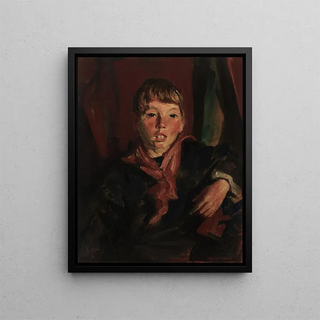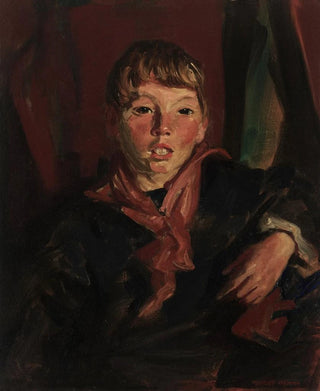Art print | Sablonneux - Robert Henri


View from behind

Frame (optional)
The "Sablonneux" art print by Robert Henri is a piece that transports viewers into a universe where light and color intertwine to create a vibrant and dynamic atmosphere. Painted in the early 20th century, this work embodies the spirit of its time, an era when art emancipated itself from academic conventions to explore new avenues of expression. Henri, a prominent figure of the American realist movement, manages to capture the fleeting beauty of landscapes and everyday scenes, while infusing his creations with emotional depth. In "Sablonneux," he succeeds in evoking a transient moment, a subtle interaction between man and nature, inviting contemplation.
Style and uniqueness of the work
Robert Henri's style is distinguished by his bold approach and expressive use of color. In "Sablonneux," warm and earthy tones dominate, creating a striking contrast with the cooler shades that animate the painting. The brushstrokes, both lively and controlled, bring to life a landscape that seems to vibrate under the effect of light. Henri does not merely depict a landscape; he captures its very essence, the poetry of passing moments, while instilling a sense of movement. The composition is carefully orchestrated, with each element finding its place in a harmonious balance. This work is not limited to a simple painting; it becomes an open window to a world where nature and humanity coexist in perfect symbiosis.
The artist and his influence
Robert Henri, born in 1865, is one of the leading representatives of American realism and an influential member of the Ashcan School, an artistic movement that sought to depict urban life and the working classes authentically. His work was marked by a quest for truth and a desire to pay homage to the beauty of ordinary scenes. Henri also played a crucial role in art education, influencing an entire generation of artists. His approach to painting, which favors personal experience and interaction with the subject, paved the way for new artistic explorations. Through his works, he was able to convey a vision of the world that

Matte finish

View from behind

Frame (optional)
The "Sablonneux" art print by Robert Henri is a piece that transports viewers into a universe where light and color intertwine to create a vibrant and dynamic atmosphere. Painted in the early 20th century, this work embodies the spirit of its time, an era when art emancipated itself from academic conventions to explore new avenues of expression. Henri, a prominent figure of the American realist movement, manages to capture the fleeting beauty of landscapes and everyday scenes, while infusing his creations with emotional depth. In "Sablonneux," he succeeds in evoking a transient moment, a subtle interaction between man and nature, inviting contemplation.
Style and uniqueness of the work
Robert Henri's style is distinguished by his bold approach and expressive use of color. In "Sablonneux," warm and earthy tones dominate, creating a striking contrast with the cooler shades that animate the painting. The brushstrokes, both lively and controlled, bring to life a landscape that seems to vibrate under the effect of light. Henri does not merely depict a landscape; he captures its very essence, the poetry of passing moments, while instilling a sense of movement. The composition is carefully orchestrated, with each element finding its place in a harmonious balance. This work is not limited to a simple painting; it becomes an open window to a world where nature and humanity coexist in perfect symbiosis.
The artist and his influence
Robert Henri, born in 1865, is one of the leading representatives of American realism and an influential member of the Ashcan School, an artistic movement that sought to depict urban life and the working classes authentically. His work was marked by a quest for truth and a desire to pay homage to the beauty of ordinary scenes. Henri also played a crucial role in art education, influencing an entire generation of artists. His approach to painting, which favors personal experience and interaction with the subject, paved the way for new artistic explorations. Through his works, he was able to convey a vision of the world that






